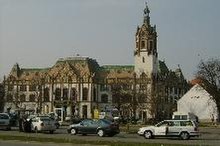Kiskunfélegyháza
| Kiskunfélegyháza | ||||
|
||||
| Basic data | ||||
|---|---|---|---|---|
| State : | Hungary | |||
| Region : | Southern Great Plain | |||
| County : | Bács-Kiskun | |||
| Small area until December 31, 2012 : | Kiskunfélegyháza | |||
| District since 1.1.2013 : | Kiskunfélegyháza | |||
| Coordinates : | 46 ° 42 ′ N , 19 ° 51 ′ E | |||
| Height : | 96 m | |||
| Area : | 256.36 km² | |||
| Residents : | 30,305 (Jan. 1, 2011) | |||
| Population density : | 118 inhabitants per km² | |||
| Telephone code : | (+36) 76 | |||
| Postal code : | 6100 | |||
| KSH kódja: | 20297 | |||
| Structure and administration (as of 2016) | ||||
| Community type : | city | |||
| Mayor : | József Csányi (Nemzeti Fórum) | |||
| Postal address : | Kossuth et al. 1 6100 Kiskunfélegyháza |
|||
| Website : | ||||
| (Source: A Magyar Köztársaság helységnévkönyve 2011. január 1st at Központi statisztikai hivatal ) | ||||
Kiskunfélegyháza [ ˈkiʃkunˈfelɛɟˈhazɒ ] (German Feulegaß later Felegyhaza ) is a Hungarian town in the district of the same name in Bács-Kiskun County . With around 30,000 inhabitants, Kiskunfélegyháza is the third largest city in the county.
Location and traffic
The city is about 120 km southeast of the capital Budapest , 25 km southeast of the county seat and the eighth largest city in the country, Kecskemét , and 60 km northwest of the fourth largest city in Hungary, Szeged .
The city is also an important rail hub. It lies on one of the main routes in the country, the railway line from Budapest via Cegléd to Szeged. Here branch lines branch off to Lakitelek and Szolnok , to Csongrád and Szentes and to Kiskunhalas and Bácsalmás .
The city also has a connection to the M5 motorway and a non-public unpaved airfield .
history
The city was first mentioned in the 14th century when the Kipchak ruler Kötöny and his entourage settled here. The name Kiskunfélegyháza is translated as "Small Human half-church" and possibly reminds of the Christianization of the area during this time. The city was completely destroyed during the Turkish Wars of the 17th century. It was rebuilt from 1743 onwards. The railway line from Pest to Cegléd was built in 1853 and extended to Szeged in 1854 ( Budapest-Szeged line of the Austro-Hungarian Railway).
Attractions
The town hall was built in 1911 according to plans by the architect József Vas (1866–1910). It is an important example of the Hungarian Art Nouveau . The rich floral ornamentation goes back to the Hungarian folk art , which was used particularly often by shepherds. The green roof, made of majolica panels from the Zsolnay porcelain factory , is also striking .
sons and daughters of the town
- Sándor Petőfi (1823–1849), poet
- Alexander Kohut (1842-1894), rabbi
- Michael Guttmann (1872–1942), scholar and rabbi
- Ferenc Móra (1879–1934), writer, journalist and museum scholar
- Ferenc Berkes (1893–1919), journalist and politician
- Tibor Simanyi (1924–2008), historian and author
- László Zarándi (* 1929), track and field athlete
- László Réczi (* 1947), wrestler
- László Vadász (1948–2005), chess grandmaster
- Csaba Tabajdi (* 1952), politician and diplomat
- István Messzi (1961–1991), weightlifter
- György Mizsei (* 1971), boxer
Town twinning
-
 Braunfels (Hessen) in Germany .
Braunfels (Hessen) in Germany . -
 Sighișoara in Romania
Sighișoara in Romania
-
 Kjellerup in Denmark
Kjellerup in Denmark
-
 The ones in France
The ones in France
-
 Eeklo in Belgium
Eeklo in Belgium
-
 Feltre in Italy
Feltre in Italy
-
 Corund in Romania
Corund in Romania
Web links
- Félegyháza , in A Pallas Nagy Lexikona ( Hungarian )
Individual evidence
- ^ Anneliese Keilhauer: Hungary. DuMont art travel guide. DuMont Buchverlag, Cologne 1990, p. 474


